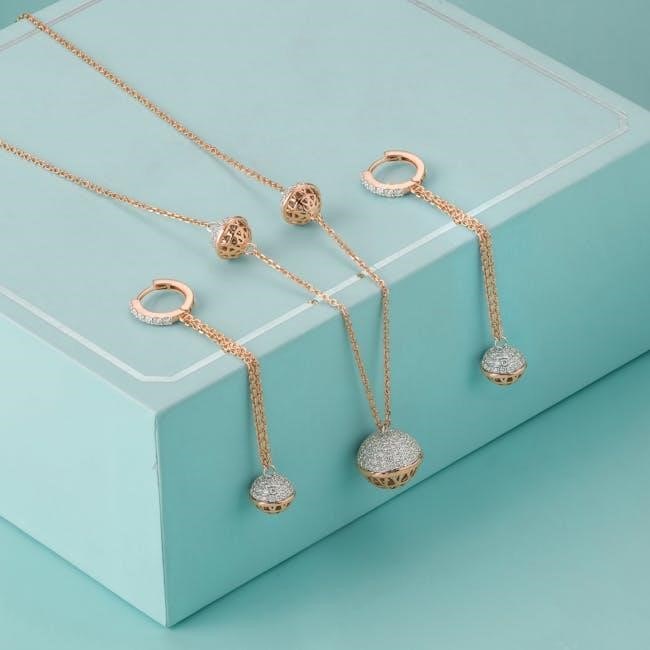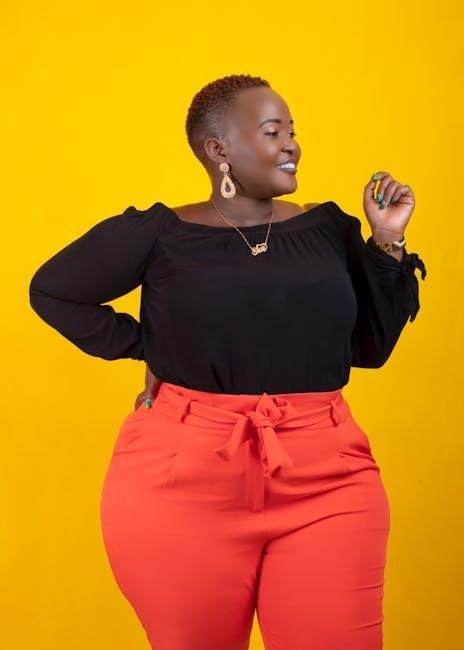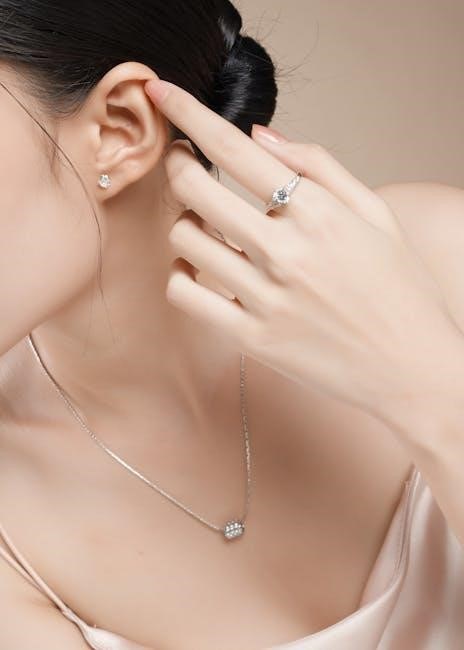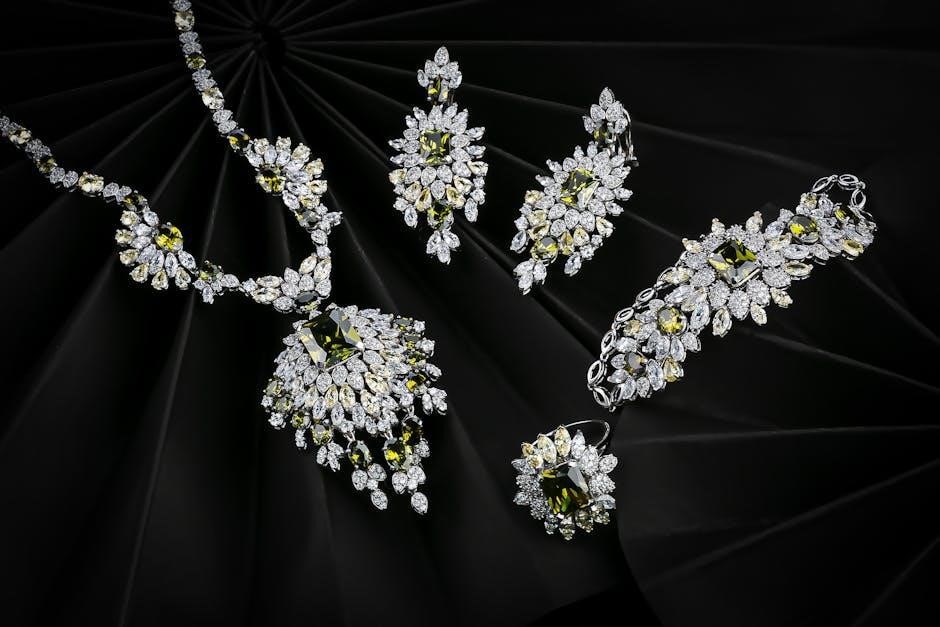Diamond earring sizes vary, influencing their aesthetics and personal style. Understanding carat weight and millimeter diameter helps choose the perfect pair; Size impacts sparkle, proportions, and overall appeal, making it a key decision factor.
Understanding the Importance of Size in Diamond Earrings
The size of diamond earrings plays a crucial role in their overall appeal and functionality. Whether you prefer subtle elegance or bold statements, the right size enhances your style and comfort. Diamond size is measured in carats and millimeters, with carat referring to weight and millimeters indicating physical dimensions. Larger diamonds naturally draw more attention, while smaller ones offer a delicate look. The size should complement your face shape and ear proportions to ensure a balanced appearance. For instance, smaller faces or ears may look overwhelmed by overly large earrings, while larger features can pull off bigger designs. Additionally, lifestyle and usage are key factors—smaller studs are ideal for daily wear, while larger earrings suit special occasions. Budget also plays a role, as larger diamonds are generally more expensive. Ultimately, the size of your diamond earrings should reflect your personal style, practical needs, and preferences for sparkle and visibility.

Diamond Earring Size Chart
A diamond earring size chart compares carat weight to millimeter diameter, aiding in selecting the perfect size; It helps balance style, budget, and personal taste for a flawless fit and sparkle.
Carat Weight vs. Millimeter Size: What’s the Difference?
Carat weight measures a diamond’s mass, while millimeter size refers to its diameter. Both factors are crucial in determining the earring’s appearance. A larger carat weight often correlates with a bigger millimeter size, but cut quality can influence how the diamond looks. For instance, a well-cut diamond may appear larger than a heavier carat weight with a poor cut. Understanding this difference helps in making informed decisions, ensuring the chosen diamond earrings complement the wearer’s features and style. Additionally, knowing how carat weight and millimeter size relate assists in balancing budget and desired visual impact, making the selection process more straightforward and personalized;
Common Size Ranges for Diamond Stud Earrings
Diamond stud earrings are available in a variety of sizes to suit different preferences and budgets. The most common size range for diamond studs is between 0.25 carats and 2 carats per earring, with the total carat weight being double that for a pair. Smaller sizes, such as 0.25 to 0.5 carats, are ideal for delicate looks and everyday wear, while larger sizes, like 1 to 2 carats, make a bold statement. The choice of size often depends on the wearer’s face shape, ear size, and personal style. Additionally, the perceived size of the diamond can be enhanced by its cut and setting. For those seeking affordability without compromising sparkle, lab-grown diamonds offer a cost-effective option. Ultimately, the size range selected should balance visual appeal with comfort and practicality, ensuring the earrings complement the wearer’s features and lifestyle.

How to Measure Diamond Earrings
Measuring diamond earrings involves assessing carat weight and millimeter size. Use a jeweler’s loupe or digital caliper to determine the diamond’s diameter accurately, ensuring proper sizing for a natural fit.
Tools and Methods for Accurate Measurement
Accurate measurement of diamond earrings requires the right tools and techniques. A digital caliper is the most precise tool for measuring millimeter size. Place the earring securely and measure the diamond’s diameter. For carat weight, a jeweler’s scale is essential. Use a loupe to examine inclusions and ensure clarity. Proper lighting helps in assessing proportions. Calibration ensures accurate readings. Regular maintenance of tools prevents measurement errors. Always seek professional measurement for high-value earrings to ensure precision.
Converting Carat Weight to Millimeter Diameter
Converting carat weight to millimeter diameter is crucial for understanding diamond earring sizes. While there’s no exact formula due to variations in cut and shape, a 0.5-carat diamond typically measures about 4mm in diameter, and a 1-carat diamond is roughly 6.4mm. Use a digital caliper for precise measurements. Factors like diamond shape and cut influence size. Round brilliant diamonds are more compact than elongated shapes like oval or emerald cuts. For accurate conversion, consult a professional jeweler or use a reliable size chart. This ensures the diamond’s physical dimensions align with its carat weight, helping you choose the perfect size for your style and comfort.

Factors to Consider When Choosing Diamond Earring Size
When selecting diamond earring size, consider face shape, ear size, lifestyle, and occasion. Larger diamonds suit bold styles, while smaller ones offer understated elegance. Balance personal taste with practicality for the perfect fit.
Face Shape and Ear Size
Face shape and ear size play a crucial role in determining the ideal diamond earring size. Oval faces can pull off various sizes, while round faces benefit from longer, slender earrings to create balance. Square faces look best with softer, rounded designs, and heart-shaped faces are complemented by delicate, drop-style earrings. Ear size also matters, as larger ears may require more substantial earrings to maintain proportion. Consider the natural shape of the face and the size of the ears to ensure the earrings enhance, rather than overpower, the features. This balance ensures a harmonious and polished look, making the earrings a perfect addition to any style. By matching the earring size to these personal attributes, the overall aesthetic becomes more tailored and flattering.
Lifestyle and Usage
Lifestyle and usage are essential factors in choosing diamond earring sizes. Active individuals may prefer smaller, more practical studs for everyday wear, while those who enjoy formal events might opt for larger, statement pieces. Consider how often the earrings will be worn and in what settings. For example, delicate 0.5-carat studs are ideal for casual, daily use, while 1-carat or larger diamonds may be reserved for special occasions. Personal style also plays a role, as some prefer understated elegance, while others embrace bold, eye-catching designs. Additionally, lifestyle considerations include durability and comfort, as smaller diamonds are less likely to catch on clothing or cause discomfort. Secure earring backs, like screw backs, are recommended for active lifestyles to prevent loss. Balancing size, comfort, and personal style ensures the earrings suit both daily wear and specific occasions, making them a versatile and lasting accessory.
Occasion and Style
The occasion and personal style significantly influence the choice of diamond earring size. For formal events, larger diamonds, typically 1 carat or more, create a bold, luxurious statement, complementing elegant attire. Smaller studs, around 0.5 carats, are ideal for casual, everyday wear, blending seamlessly with a relaxed look. Style preferences also play a role, as some may favor timeless, classic designs, while others opt for trendy, eye-catching pieces. Consider pairing smaller earrings with delicate necklaces or larger ones with simplistic outfits to maintain balance. Additionally, the earring’s cut and setting can enhance its appeal for specific occasions—princess or round cuts for versatility, and halo settings for added glamour. Ultimately, aligning the earring size with the occasion and personal style ensures they enhance the overall look, making them a versatile and meaningful accessory for any setting or wardrobe choice.
